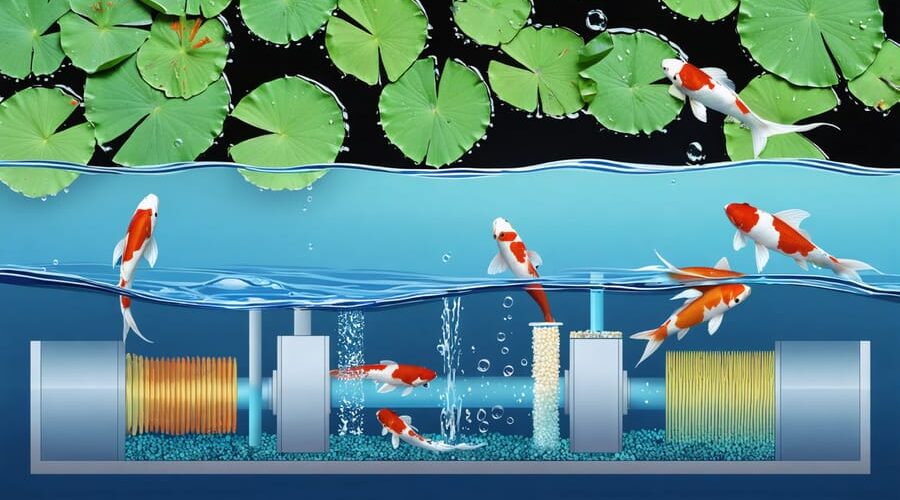
Crystal Clear Success: The Perfect Koi Pond Filter for Your Water Garden
Selecting the right pond filter determines your koi’s health, water clarity, and overall maintenance requirements. A properly sized filtration system processes both mechanical debris and biological waste, maintaining optimal koi pond water chemistry for thriving fish. Modern koi pond filters fall into three essential categories: pressurized systems for smaller ponds up to 2,000 gallons, gravity-fed units for mid-sized collections, and professional-grade drum filters for serious koi enthusiasts with ponds exceeding 5,000 gallons. Each system offers distinct advantages in bio-load handling, maintenance frequency, and installation complexity. This guide cuts through the confusion, presenting clear recommendations based on pond size, fish population, and budget considerations to help you make an informed decision for your specific setup.
Understanding Koi Pond Filtration Basics
Mechanical vs. Biological Filtration
When it comes to keeping your koi pond crystal clear and healthy, understanding the two main types of filtration is crucial. Mechanical filtration acts as your pond’s first line of defense, catching physical debris like leaves, fish waste, and floating particles. Think of it as a giant strainer that prevents larger waste from breaking down and clouding your water. This process typically involves filter mats, screens, or brushes that trap debris before it can sink to the bottom.
Biological filtration, on the other hand, works through natural filtration processes that break down harmful substances. Beneficial bacteria colonize special filter media, converting toxic ammonia from fish waste into less harmful nitrates. This type of filtration is essential for maintaining the delicate ecosystem that keeps your koi healthy and thriving.
For the best results, you’ll want a filter system that combines both types. While mechanical filtration keeps your pond looking clean, biological filtration maintains the water quality that your koi need to flourish. Think of it as a tag-team approach – mechanical filtration catches the visible stuff, while biological filtration handles the invisible but equally important aspects of water quality.
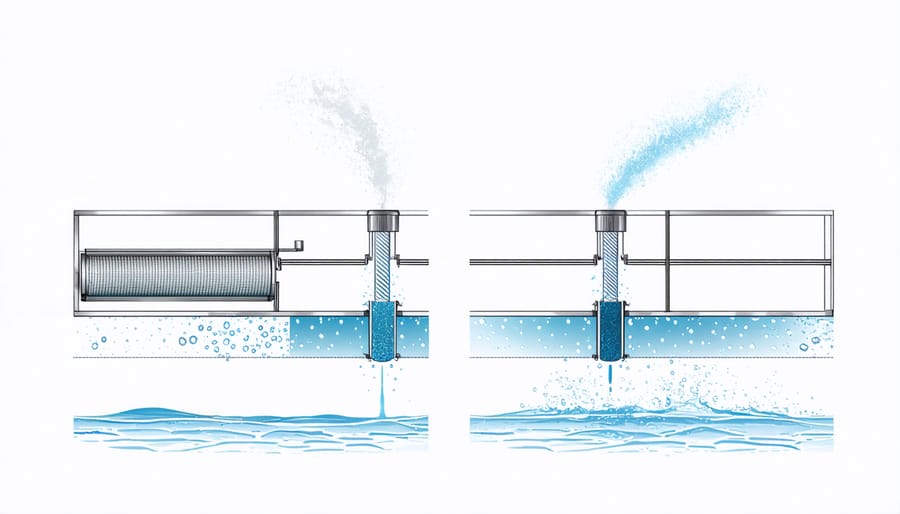
Why Koi Need Special Filtration
Koi fish are magnificent creatures, but they’re also messy eaters and prolific waste producers. Unlike regular pond fish, koi can grow quite large – often reaching lengths of 24 inches or more – and they tend to be voracious eaters. This combination means they produce significantly more waste than typical pond fish.
What makes koi special is their sensitive gill system, which requires exceptionally clean water to thrive. Their constant foraging behavior also stirs up bottom debris, creating additional filtration challenges. A single adult koi can produce several pounds of waste per year, and in a typical koi pond with multiple fish, this quickly adds up.
This is why standard pond filters often fall short for koi ponds. Koi require a three-stage filtration system: mechanical filtration to remove solid waste, biological filtration to process ammonia and nitrites, and fine filtration to polish the water. Without proper filtration, koi can develop health issues, their colors may fade, and the pond water can become cloudy and unhealthy.
Top Pond Filters for Different Koi Pond Sizes
Small Ponds (Up to 1,000 Gallons)
For small koi ponds up to 1,000 gallons, choosing the right filter is crucial for maintaining crystal-clear water and healthy fish. Pressurized filters are particularly effective for these compact spaces, offering excellent filtration without taking up too much room around your pond.
The TetraPond Bio-Active Pressure Filter is our top pick for small ponds, providing both mechanical and biological filtration in one compact unit. It handles ponds up to 1,000 gallons efficiently and includes a convenient backwash function that makes maintenance a breeze.
For budget-conscious pond owners, the OASE Filtoclear Pressure Filter offers great value while maintaining reliable performance. It’s particularly effective at handling string algae and comes with an integrated UV clarifier to keep green water at bay.
If you prefer an all-in-one solution, the Laguna Pressure-Flo Filter System combines mechanical, biological, and UV filtration in a single unit. It’s perfect for newer pond owners who want a simple yet effective setup.
When selecting a filter for your small pond, remember that even though your pond is compact, you’ll still need adequate filtration power for koi. A good rule of thumb is to choose a filter rated for at least 1.5 times your actual pond volume to account for these messy fish. Also, consider models with easy-access cleaning features, as regular maintenance is key to keeping your filter working effectively.
Medium Ponds (1,000-5,000 Gallons)
For medium-sized koi ponds between 1,000 and 5,000 gallons, you’ll need robust filtration to handle the increased bioload. Multi-stage filtration systems are ideal for these ponds, offering comprehensive water treatment through mechanical and biological filtration.
The Aqua UV Ultima II 2000 is a standout choice, combining a pressurized filter with UV clarification. It handles ponds up to 4,000 gallons and requires minimal maintenance, making it perfect for busy pond owners. Another excellent option is the Evolution Aqua Nexus 320+, which uses innovative K1 media and can support ponds up to 5,000 gallons.
For budget-conscious pond keepers, the SunSun Bio Pressure Filter offers great value without compromising performance. It features a built-in UV clarifier and works well for ponds up to 2,500 gallons. The Oase BioSmart 5000 is another reliable choice, featuring an easy-clean system and temperature display.
Remember to consider your specific needs when choosing a filter. Factors like fish stock levels, plant coverage, and local climate can affect filter performance. For heavily stocked koi ponds, it’s better to choose a filter rated for a larger size than your actual pond volume to ensure optimal filtration.
Regular maintenance is crucial for these systems, but most modern filters come with convenient cleaning features that make upkeep manageable. Look for models with backwash functions and easy-access cleaning ports to simplify maintenance routines.
Large Ponds (5,000+ Gallons)
For large koi ponds exceeding 5,000 gallons, you’ll need robust filtration systems that can handle substantial bioloads and maintain crystal-clear water. Bead filters are particularly effective at this scale, with models like the Aquadyne 22000 or Emperor Aquatics Genesis offering excellent mechanical and biological filtration capabilities.
Multi-chamber systems are another fantastic option for large ponds. These typically include settlement chambers, moving bed biological reactors (MBBR), and UV clarifiers all working in harmony. The Oase ProfiClear Premium Drum Filter system is a standout choice, automatically removing debris while providing optimal biological filtration for your precious koi.
For the budget-conscious pond keeper, DIY gravity-fed systems using multiple filter tanks can be equally effective. Consider combining large settlement tanks with brush chambers, Japanese matting, and bio-media chambers. This approach allows for customization based on your specific needs while maintaining excellent filtration capacity.
Remember that large ponds benefit greatly from bottom drains and multiple skimmers to ensure proper water circulation. Incorporating air-driven systems like bakki showers can also enhance oxygenation and biological filtration, creating the perfect environment for your koi to thrive.
Whatever system you choose, ensure it can process your entire pond volume at least once every two hours to maintain optimal water quality for your koi collection.
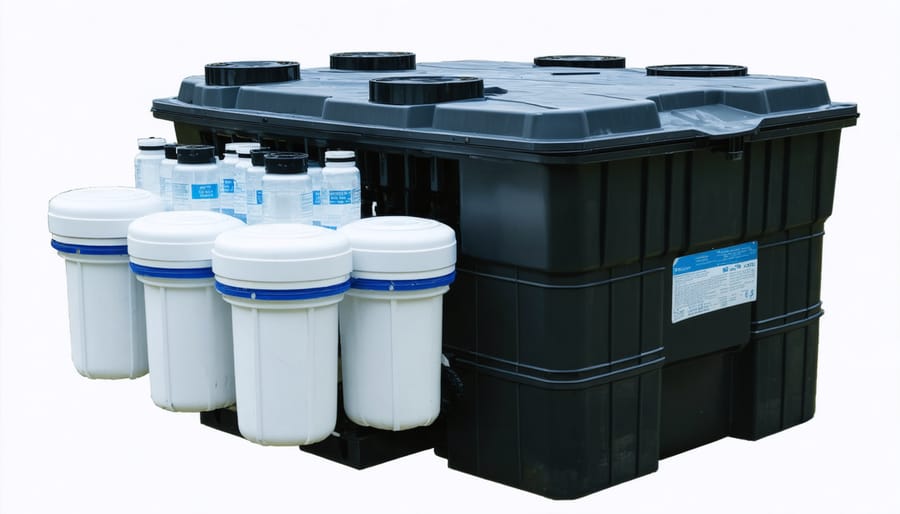
Essential Features to Look For
Flow Rate and Capacity
Selecting the right flow rate and capacity for your koi pond filter is crucial for maintaining a healthy aquatic environment. As a general rule, your filter system should process the entire pond volume at least once every two hours. For koi ponds, aim for a higher turnover rate – ideally once per hour – to handle the heavier bioload these beautiful fish produce.
To calculate your needed flow rate, first determine your pond’s volume in gallons (length x width x average depth x 7.48). For example, a 1,000-gallon koi pond would need a filter system capable of processing at least 500 gallons per hour (GPH), though 1,000 GPH would be optimal. Remember that proper pond aeration works hand in hand with filtration for the best results.
When choosing a filter, always select one rated for a pond slightly larger than yours. This provides a safety margin and accounts for future fish growth. Be aware that actual flow rates are usually lower than manufacturer ratings due to factors like pipe bends, height differences, and filter media resistance. It’s better to oversize your filter than to risk insufficient filtration, which can lead to poor water quality and stressed fish.
Keep in mind that seasonal changes might require adjusting your flow rate, with higher rates needed during warmer months when fish are more active and producing more waste.
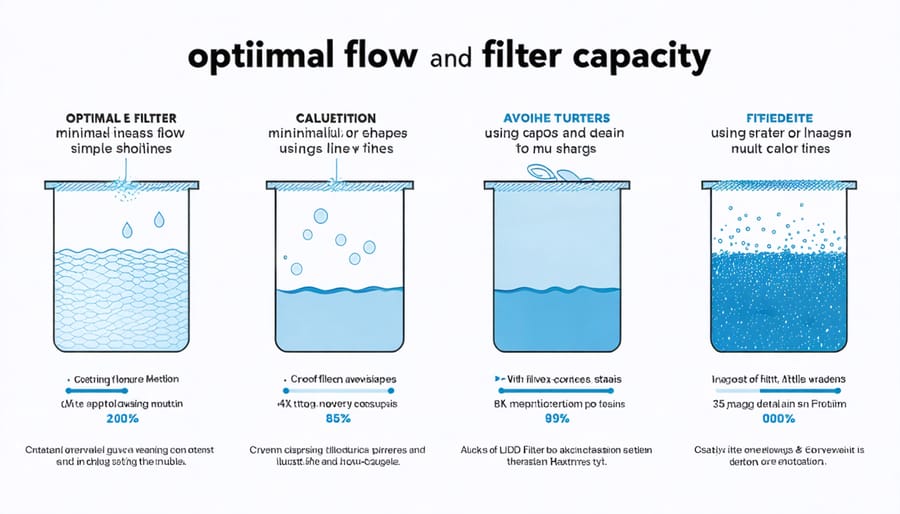
Maintenance Requirements
Regular maintenance is key to keeping your koi pond filter working efficiently and your fish healthy. Most modern koi pond filters require cleaning every 2-4 weeks, though this can vary depending on your pond’s size, fish population, and seasonal factors.
For mechanical filters, backwashing is typically required when you notice reduced water flow. This process usually takes about 10-15 minutes and involves reversing the water flow to flush out accumulated debris. Pressure filters often come with convenient cleaning handles that make this task even simpler.
Biological filter media needs gentler cleaning to preserve beneficial bacteria. Rather than washing with tap water, use pond water to rinse the media, ensuring you don’t disrupt the bacterial colony. UV clarifiers require bulb replacement annually, and the quartz sleeve should be cleaned every few months to maintain effectiveness.
During seasonal maintenance, pay special attention to:
– Checking seals and connections for leaks
– Cleaning or replacing filter pads
– Removing and rinsing filter media
– Inspecting pump functionality
– Clearing any blocked inlets or outlets
Winter preparation is crucial – some filters need to be removed and stored, while others can remain operational with reduced flow. Always follow manufacturer guidelines for specific maintenance schedules and procedures to extend your filter’s lifespan and maintain optimal performance.
Installation and Maintenance Tips
Proper Installation Guidelines
Installing your koi pond filter correctly is crucial for maintaining a healthy aquatic environment. Follow these simple steps for a successful setup:
First, choose an accessible location near your pond for the filter system. Ensure it’s on level ground and slightly elevated to allow proper water flow. If you’re installing a pressurized filter, it can be partially buried for a more aesthetic look.
Begin by connecting the pump to your filter’s inlet using appropriate PVC piping or flexible tubing. Always use clamps to secure connections and prevent leaks. For gravity-fed systems, position the filter higher than the pond’s water level to create natural flow.
Next, attach the outlet pipe that returns filtered water to your pond. Create a gentle waterfall effect if desired – this helps with oxygenation. Remember to measure and cut pipes accurately, using primer and cement for PVC connections.
Before starting the system, double-check all connections and make sure filter media is properly placed according to manufacturer instructions. Most filters use a layered approach, with coarse media first, followed by finer materials.
Finally, prime your pump and plug it in. Watch for leaks and adjust flow rates as needed. Let the system run for 24 hours before adding beneficial bacteria to jump-start the biological filtration process.
Pro tip: Keep your instruction manual handy and perform a test run with clean water before adding fish to ensure everything works perfectly.
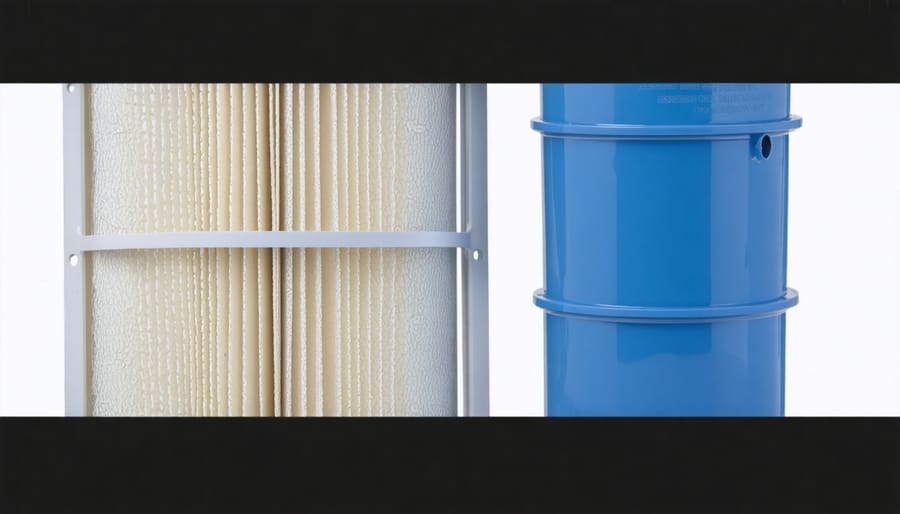
Seasonal Maintenance Schedule
Keeping your koi pond filter in top condition requires different maintenance tasks throughout the year. In spring, start by thoroughly cleaning the filter system after winter dormancy. Remove debris, clean filter media, and check all mechanical components. This is also an ideal time for water quality testing to ensure your system is ready for increased fish activity.
During summer months, increase cleaning frequency as higher temperatures lead to more biological activity. Check filter media every 2-3 weeks, rinse mechanical filters, and monitor water flow rates. Remember to never clean biological media with tap water – use pond water to preserve beneficial bacteria.
Fall maintenance focuses on preparing for winter. Remove excess debris before leaves fall, clean UV clarifiers, and check all seals and connections. Consider installing a net over your pond to prevent leaves from overwhelming the filter system.
In winter, reduce but don’t eliminate maintenance. While biological filtration slows down, mechanical filtration remains important. Check the system monthly, remove any ice buildup around filter boxes, and ensure water flow continues to prevent freezing.
Year-round, keep spare parts handy and maintain a cleaning schedule. Regular maintenance prevents major issues and extends your filter’s lifespan, keeping your koi healthy and your pond crystal clear.
Common Filtration Mistakes to Avoid
When maintaining a koi pond, even small filtration mistakes can have significant consequences for your fish’s health. Let’s explore some common pitfalls and learn how to avoid them for optimal pond health.
Undersizing your filter is perhaps the most frequent mistake pond owners make. Always choose a filter rated for a pond slightly larger than yours, especially when keeping koi. Remember, it’s better to have too much filtration than too little.
Another critical error is placing mechanical and biological filtration in the wrong order. Mechanical filtration should always come first to remove larger debris before water reaches the biological filter media. This prevents clogging and maintains the efficiency of beneficial bacteria colonies.
Many pond owners skip regular maintenance, thinking filters are “self-cleaning.” This couldn’t be further from the truth. Neglecting routine cleaning leads to reduced efficiency and can even cause harmful backup of waste materials. Schedule regular maintenance checks and cleanings based on your filter manufacturer’s recommendations.
Installing the filter in direct sunlight is another common mistake. UV exposure can encourage algae growth inside the filter and potentially damage plastic components over time. Choose a shaded location or create artificial shade for your filtration system.
Don’t forget about winter preparation. Failing to properly winterize your filter can lead to cracked housings and damaged components. Either keep your filter running with proper freeze protection or shut it down and store it correctly during cold months.
Lastly, many people overlook the importance of proper media replacement schedules. While it’s tempting to extend the life of filter media to save money, using worn-out media reduces filtration effectiveness and can compromise water quality. Keep track of when different types of media need replacement and stick to the schedule.
Remember, addressing these common mistakes early can save you time, money, and potential stress on your koi fish in the long run.
Choosing the right filter for your koi pond is crucial for maintaining a healthy and thriving ecosystem. Throughout this guide, we’ve explored various filtration options that cater to different pond sizes and needs. Whether you’re working with a small backyard pond or managing a larger water feature, remember that the key factors in your decision should be pond size, fish load, and maintenance requirements.
For smaller koi ponds under 1,000 gallons, pressure filters offer an excellent balance of efficiency and ease of use. Mid-sized ponds benefit greatly from combined mechanical and biological filtration systems, while larger ponds typically require more robust solutions like multi-chamber filters or professional-grade systems.
When making your final decision, consider these essential takeaways:
– Always choose a filter rated for a slightly larger pond than yours
– Factor in your local climate and seasonal changes
– Consider the long-term maintenance requirements
– Don’t compromise on quality for cost savings
– Ensure the system includes both mechanical and biological filtration
For most koi enthusiasts, we recommend starting with a three-stage filtration system that includes mechanical filtration, biological media, and UV clarification. This combination provides optimal water quality and clarity while keeping maintenance manageable.
Remember that even the best filter needs regular maintenance to perform effectively. Schedule regular cleaning sessions, monitor water parameters, and adjust your system as your pond ecosystem evolves. With the right filter and proper care, you’ll create the perfect environment for your koi to thrive and grow.
